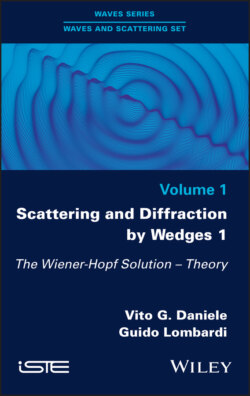Читать книгу Scattering and Diffraction by Wedges 1 - Vito G. Daniele - Страница 6
Оглавление
Preface
The theory of wave diffraction by wedges constitutes one of the fundamental problems in mathematical physics. Beyond the obvious applications to engineering and physics, this topic has generated – and continues to generate – new progress in the techniques of applied mathematics (e.g. the Sommerfeld–Malyuzhinets technique and the Kontorovich–Lebedev method), and applied physics (e.g. the geometrical theory of diffraction and the physical theory of diffraction).
The scattering of wedge structures is of interest in the study of electromagnetic response/interaction of more complex, multiscale computational electromagnetic problems, using diffraction coefficients for modeling subdomains where high-frequency methods hold promise.
This book, which is divided into two volumes, presents a general flexible, novel and powerful methodology for solving problems of electromagnetism in regions containing arbitrary wedge objects; this technique can be extended, as suggested, to different physics.
The proposed technique is based on a generalization of the Wiener-Hopf (WH) technique that allows the study of complex canonical scattering problems.
Research carried out during the past two decades has ordered and systematized the procedure, to obtain spectral equations and integral representations for complex problems to avoid redundancy.
The purpose of this book is to present the application of the so-called generalized Wiener-Hopf technique (GWHT) to wedge scattering problems. This method often adopts very sophisticated mathematical methods; however, since the aim of the authors is to favor the acquisition of fundamental concepts in view of possible applications, they prefer to omit rigorous mathematical proofs for theory such as theorems. For all unproven mathematics, we refer to papers and books that are easily available.
Due to the electrical engineering background of the authors, the two volumes are focused on electromagnetic applications. However all of the material is presented in such a way that extension to other physics and applied mathematical fields is straightforward; from applications in all areas of diffraction problems, such as acoustics, elasticity, aerodynamics, hydrodynamics and so on.
Analogies between some resolved problems in electromagnetics and other areas of physics are reported. In particular, for example, the diffraction of a half-infinite crack in an elastic solid medium is described in detail.
Before dealing with the applications to wedge problems, we present some useful remarks about the WH technique. First, the classical and consolidated method of solution of WH equations is founded on a deep knowledge of the properties of complex functions, which is based on the following classical steps: the multiplicative factorization of the kernel, the additive factorization (decomposition) of functions and the application of Liouville’s theorem.
Second, in general, no WH problem is simple to study and solve. The formulation can be cumbersome to obtain and very specialized techniques are needed to implement the factorization procedure. Moreover, these methods frequently do not allow small variations of the problem itself. In this context, it is fundamental to adopt spectral domains using spatial Laplace transforms where all the unknown field representations are analytic functions.
Furthermore, even though formal solutions can be obtained in particular cases, a long and difficult elaboration may be required to make them effective from the physical and engineering points of view. For this purpose, tools such as the saddle point method are necessary for the asymptotic evaluation of integrals.
In this book, we aim to solve these problems systematically by helping the reader to implement solutions using the WH method with precise, simple steps and reducing the restrictions on generalization.
In particular, we present one of the most relevant recent advances in the WH technique, i.e. the transformation of WH equations into integral equations for their effective solution via simple discretization.
This method, known as the Fredholm factorization, is an approximate technique that extends the applicability of the WH method to a new variety of problems, consisting of different geometries and materials.
The Fredholm factorization is a semi-analytical solution method that preserves the spectral properties of the problem through its structural singularities and singularities related to the sources. Approximations are present on correction terms that are only related to diffractive properties. Thus, using a suitable analytic continuation, the method allows the reader to look at the physical properties of the problems, as done in analytical closed-form solution methods.
The success of the Fredholm factorization, in solving complex diffraction problems involving isotropic media, has also encouraged the authors to extend the WH technique developed in this book to wedge problems involving anisotropic or, more general, bi-anisotropic media. Moreover, in these cases, the Fredholm factorization is conceptually possible. However, in most cases, it yields complex kernels that involve cumbersome multivalued functions. Much effort is needed to complete the general WH theory for solving wedge problems involving arbitrary linear media. In particular, difficulties increase considerably when it is not possible to take advantage of the presence of Helmholtz equations. In fact, in these cases, it is very difficult and cumbersome to implement the indispensable analytic continuation procedures.
However, to successfully develop the mathematical theory and applications of this book, it is useful to have a technical computing software, particularly in analytical and numerical manipulations of the equations.
Finally, we admit that the authors are strongly influenced by the fundamental work of Felsen and Marcuvitz on radiation and scattering by waves, and therefore the adopted notations follow their studies. In particular, equivalent network representations of equations are provided to systemize the mathematical procedure. The use of different notations in applied physics, applied mathematics and engineering communities should not present a major difficulty in reading this book.
Vito G. Daniele
Guido Lombardi
May 2020
